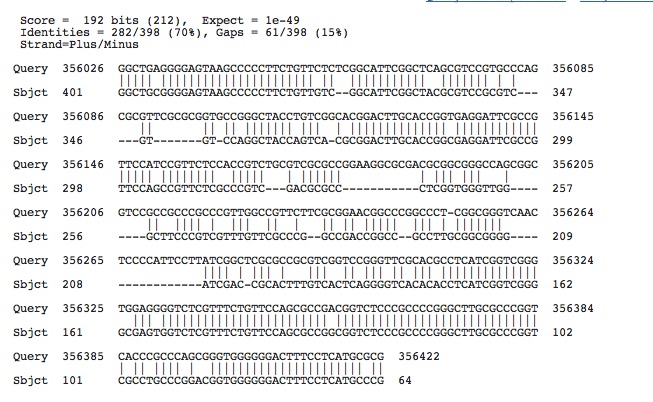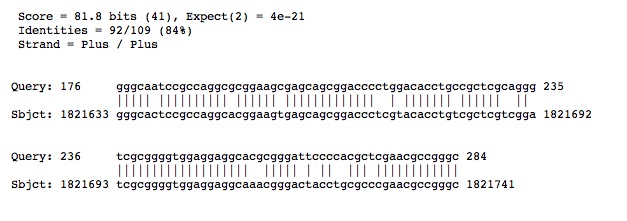Missing RNA genes? 2009
In looking for other RNA genes we did the following. . .
1). We looked at the two "other RNA" genes from last year's species (Halorhabdus utahensis AX-2, DSM 12940) and compared those sequences to our species entire genome in two different manners:
A). Blast2 of somewhat similar sequences
and
B). Halomicrobium mukohataei genome portal
Results are as follows. . .
For "other RNA" gene 2500590731, named SRP_euk_arch, in the Halorhabdus utahensis AX-2, DSM 12940 genmone (820149..820441 (-)(293bp)):
A). Blast2 Results
 B). Genome Portal Results
B). Genome Portal Results

For "other RNA" gene 2500590732, named RNaseP_arch, in the Halorhabdus utahensis AX-2, DSM 12940 genmone (2878153..2878553 (-)(401bp)):
A). Blast2 Results
 B). Genome Portal Results
B). Genome Portal Results

2). We also looked to ensure that all 20 amino acids had an associated tRNA gene encoded and found that all 20 amino acids were represented (although at varying frequencies).
3). We looked at the other halophiles (Halogeometricum borinquense PR3, DSM 1155 and Haliangium ochraceum SMP-2, DSM 14365 listed on the "Adopt a Genome" JGI site and none of them, besides the species annotated last year had "other RNA" genes.
4). We also examined Haloferax volcanii, a species of halophile that was found through-out our blasts results while attempting to confirm annotation of tRNA genes. The genome for this halophile has previously been annotated and is cited in conjunction with Haloferax mediterrane (the species from Spain that we are thinking about exploring). Haloferax volcanii also does not show signs of "other RNA" genes.
In the future we would like to. . .
1). Compare our species to very closely related species that have been annotated for "other RNA genes"
2). Determine what "other RNA" genes we should be looking for in archae specifically.